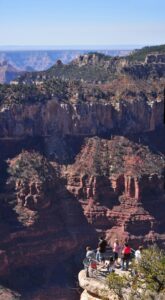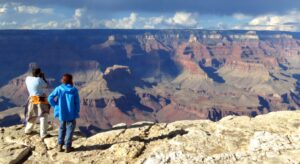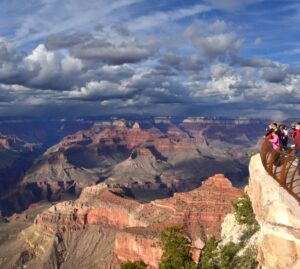Beyond the Rim

Exploring the Grand Canyon’s Timeless Allure
Writer Amanda Christmann // Photography Courtesy of Grand Canyon National Park
Arizona is home to one of the Seven Natural Wonders of the World and the only one located in North America. The colossal Grand Canyon stands as the most recognized canyon and one of the most recognizable land formations globally.
Each year, nearly 5 million visitors come to experience its breathtaking grandeur and feel the timelessness of this spectacular landmark. The 277-mile-long chasm plunges to an average 1 mile deep and stretches to 18 miles across at its widest points.
Though debate continues over just how the Grand Canyon was formed, the most commonly held belief is that erosion from the Colorado River carved its way through the strata over a period of 4 to 6 million years, revealing layer upon layer formed over nearly 2 billion years.
For the casual observer, it doesn’t really matter how the canyon came to be; its rugged character and sheer vastness are enough to render visitors speechless. Shadows shift from moment to moment, altering the palette of red and purple hues that mix with sandstone, shale and limestone.
Native Heritage and Early Exploration



The Grand Canyon was home to many Native Americans long before pioneers heading westward discovered its beauty. Ancient Puebloans, or Anasazi, are believed to have occupied the area first, as well as the Cohonina, who were ancestors of the Yuman, Havasupai and Hualapai peoples who inhabit the area today. The Sinagua people lived on land southeast of the Grand Canyon, between the Little Colorado River and the Salt River, and are believed to be the early ancestors of several Hopi clans.
Then the Europeans came, but the seldom-told story of what happened next is a victory in the annals of Native American history. In September 1540, conquistador Capt. Garcia Lopez de Cardenas and his small group of men traveled with a group of Hopi guides to the South Rim of the Grand Canyon between Desert View and Moran Point. They were in search of the mythical Seven Cities of Cibola and hidden gold.
The men descended a section of the canyon but were forced to return when they ran out of water. They never did return, and the Hopis likely celebrated this significant triumph. Unknown to the conquistadors, the Hopis frequently traversed the canyon to obtain access to the river and surely knew safe, accessible ways to get there. Their cunning paid off; Europeans did not return to the Grand Canyon for another 200 years.
A handful of adventurers with a variety of motivations for visiting the canyon came to explore it in the late 18th and 19th centuries. In 1869, one-armed Civil War hero Maj. John Wesley Powell, namesake of Lake Powell, led the first recorded expedition through the Grand Canyon. With nine men and four wooden boats, he set out from Green River, Wyoming, and traveled approximately 1,000 miles down the Colorado River, eventually reaching the mouth of the Virgin River (now submerged beneath Lake Mead). Two years later, Powell dubbed the landmark the Grand Canyon, and the name stuck.
Environmentalist, adventurer and author John Muir spent time exploring the canyon and remarked, “It seems like a gigantic statement for even Nature to make all in one mighty stone work. Wildness so Godful, cosmic, primeval, bestows a new sense of Earth’s beauty and size … But the colors, the living, rejoicing colors, chanting morning and evening in chorus to heaven! Whose brush or pencil, however lovingly inspired, can give us these? In the supreme flaming glory of sunset, the whole canyon is transfigured, as if the life and light of centuries of sunshine stored up in the rocks was now being poured forth as from one glorious fountain, flooding both earth and sky.”
In 1882, the railroad forged a path along the Grand Canyon. The Santa Fe Railroad first came through based on a collective hunch that, with all of the color and layers in the canyon, surely mineral riches would be found. Those betting their lives on it lost plenty, but when railroad officials began billing the canyon as an exciting stop along the way to the gentle climates of California, tourists began to flock to the area. Twenty years later, automobiles would become the main form of transportation, bringing families and thrill-seekers to the Grand Canyon.
Presidential Protection and National Treasure



Perhaps the most dedicated outdoorsman in presidential history, President Theodore Roosevelt visited the Grand Canyon with Muir in 1903. An avid hunter and conservationist, he established the Grand Canyon Game Preserve with the best of intentions in 1906. As a result, predators such as mountain lions, eagles and wolves were eradicated, which, in hindsight, may not have been the most ideal plan for land management.
In 1908, Roosevelt went a step further, designating the canyon and surrounding forest lands a U.S. national monument. He wanted to reclassify it as a national park, but landowners and mining claim holders stalled the process for 11 years. President Woodrow Wilson was finally able to urge legislation through, and Grand Canyon National Park was established in 1919.
“The Grand Canyon fills me with awe,” Roosevelt declared. “It is beyond comparison — beyond description; absolutely unparalleled throughout the wide world … Let this great wonder of nature remain as it now is. Do nothing to mar its grandeur, sublimity and loveliness. You cannot improve on it. But what you can do is to keep it for your children, your children’s children, and all who come after you, as the one great sight which every American should see.”
Today, visitors from around the world make pilgrimages to experience the Grand Canyon’s timeless majesty. The South Rim is open year-round, weather permitting. The North Rim is generally open mid-May to mid-October.
In 2007, the Hualapai Tribe unveiled a remarkable man-made feat that both embraces the canyon’s beauty and reveres its boldness. The Grand Canyon Skywalk, a transparent horseshoe-shaped cantilever bridge and tourist attraction some 500 to 800 feet above the canyon floor, was commissioned by the tribe in an effort to attract much-needed tourism dollars. Located on Hualapai tribal land at Grand Canyon West, the Skywalk can be reached via Grand Canyon West Airport or by driving approximately 120 miles from Las Vegas.
The Hualapai and other Native American communities that surround the Grand Canyon work diligently to maintain their ancient cultures and traditions amid urbanization, globalization and a local economy centered on tourism. Since the 1880s, outposts for jewelry and other crafts have provided both income and awareness of the importance of Native traditions. Today, these venues preserve cultural heritage while serving as some of the most popular sources of Native American handicrafts in the world.
Nature’s Masterpiece



Wildlife and botanical life are preserved in the Grand Canyon: an estimated 89 species of mammals, 17 species of fish, 355 species of birds, 47 species of reptiles and amphibians, and 1,500 species of flowering plants.
These species are protected in these special lands, and the National Park Service hopes to provide stewardship for the ecology and everything reliant on it for centuries to come. It is a continuing challenge to maintain the delicate balance often threatened by the impact of humans.
The Grand Canyon Railway was brought back to life in 1989, more than 20 years after it last traversed the beautiful South Rim. Today, it remains the only railroad operating in a national park in the United States. Though its mission has changed since its early 20th-century purpose, its significance remains.
Visitors can now experience the anticipation and excitement that generations of Americans — including many of their grandparents and great-grandparents — felt when trains first chugged through pine forests, high desert and along the breathtaking ridgelines of the canyon itself. As in days gone by, passengers get off at the Grand Canyon Depot next to the El Tovar Hotel, built by the railroad in 1905.
For those planning a summer visit, advance reservations are highly recommended for lodging within the park. The South Rim offers a range of accommodations, from the historic El Tovar to more modest options at Bright Angel Lodge. For the adventurous, backcountry permits allow for a more intimate canyon experience, though these must be secured months in advance.
Whether you’re capturing the perfect sunrise at Mather Point, hiking the popular Bright Angel Trail or simply contemplating the vastness from a quiet overlook, the Grand Canyon offers an experience that transcends time — a fitting reminder of both nature’s grandeur and our responsibility to preserve it for future generations.

